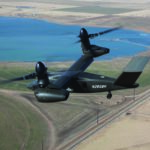
UUV Roles. The Navy is not looking for futuristic, Star Trek-like technology when it comes to unmanned underwater vehicles (UUVs), according to Rear Adm. Bill Merz, director of submarine warfare. That’s because the Navy will continue to rely on its technologically advanced manned submarines to perform the most challenging tasks. “I don’t really need the Starship Enterprise,” says Merz, who spoke Oct. 25 at the Unmanned Systems Defense conference in Arlington, Va. “I have that; it’s called the Virginia-class submarine.” But Merz also has “a spectrum of missions where I don’t need the Starship Enterprise, and I will inject these unmanned vehicles wherever they will fit in to help the overall chore of managing this undersea environment.”
Submarine Commissioning. The Navy is scheduled to commission its 13th Virginia-class attack submarine, the USS Illinois, at an Oct. 29 ceremony at Naval Submarine Base New London in Groton, Conn. Built by General Dynamics Electric Boat, the Illinois is designed to strike targets ashore with Tomahawk cruise missiles; conduct surveillance of land areas, littoral waters and other sea-based forces; perform anti-submarine and anti-ship warfare; deliver mines and map minefields; and deliver and support special forces.
DoD Innovation. Defense Secretary Ash Carter plans to create a Department of Defense chief innovation officer to be a senior adviser to the defense secretary and spearhead innovation activities across DoD. Such activities could include “building software platforms and human networks to enable workforce-driven innovation across DoD at scale, sponsoring innovation contests and tournaments and providing training and education that promotes new ideas and approaches to collaboration, creativity and critical thinking,” says Carter, who spoke Oct. 28 at the Center for Strategic and International Studies in Washington, D.C. Creation of the position is among the recent recommendations of the new Defense Innovation Board, which is chaired by the executive chairman of Google’s parent company.
FCS Lesson. While the U.S. military is often eager to field new weapon systems quickly, it needs to keep in mind that too much speed can derail an acquisition program, Pentagon acquisition chief Frank Kendall cautions. The Army’s canceled Future Combat Systems (FCS) program had unrealistic schedules and turned out to be the “biggest waste of money that I’ve seen in the Department of Defense — $13 billion thrown away, no product came out of that,” says Kendall, who spoke Oct. 28 at the Center for Strategic and International Studies in Washington, D.C. “So you have to be very careful about this. You need to listen to the professionals about how long it will take to do something.”
Stratcom Commander. Air Force Gen. John Hyten is scheduled take the helm of U.S. Strategic Command during a Nov. 3 ceremony at Offutt Air Force Base in Nebraska. Hyten, who has led Air Force Space Command in Colorado Springs, Colo., the past two years, will replace retiring Navy Adm. Cecil Haney, who has been Stratcom’s commander since November 2013.
External Probe. Following the arrest of former employee Harold Martin, who stole a mother lode of classified data from the National Security Agency, Booz Allen Hamilton asked former FBI Director Robert Mueller to review the company’s “security, personnel, and management processes and practices,” says Craig Veith, the firm’s vice president of External Relations. “We are committed to doing our part to detect potential insider threats, which are complex and constantly evolving,” Veith says. “Director Mueller has extensive experience in these areas, as well as an unparalleled reputation for integrity.” Mueller’s review began on Oct. 19. The infamous Edward Snowden was also a Booz Allen Hamilton employee.
3Q Global A&D M&A. The global consulting firm PwC says in a new report that worldwide merger and acquisition activity in the aerospace and defense industry in the third quarter of 2016 fell in terms of volume and value versus a year ago. In the recent quarter’s activity, there were 11 deals worth a combined $6.1 billion, down 39 percent and 87 percent, respectively, from a year ago, PwC says. “It would appear that uncertainty around the election, government spending, and the global economy is holding activity in check,” says Bob Long, PwC’s US Aerospace and Defense Deals Leader. “While we clearly expect volumes to recover, deal making for the remainder of 2016 may be more opportunistic in nature.”
New HART Draft RFP. Just when industry thought the Department of Homeland Security would be releasing the final Request for Proposals for a new database for storing and matching biometric data, DHS issued a draft RFP on Oct. 20 for the Homeland Advanced Recognition Technology (HART) system. The department in late September approved a decision milestone to proceed with a formal solicitation to industry for HART, but for some reason the RFP has been delayed and instead a new draft RFP has been issued. HART will initially store and match fingerprint, face and iris images. It will replace the fingerprint-based IDENT system.
Safran in Silicon Valley. France’s Safran Group says its Identity & Security business, which has a large footprint in the United States, later this year will open a facility in Silicon Valley that will feature an innovation center with a focus on digital payment, digital identity and the Internet of Things. “Being at the forefront of biometrics, digital identity and security technologies, it was the next logical step for us to become part of the vibrant innovation community in Silicon Valley,” says Anne Bouverot, CEO of Safran Identity & Security. The Identity & Security business is being sold to the private equity firm Advent International.
Root9B AF Academy. root9B announced a collaborative effort with the U.S. Air Force Academy (USAFA) to develop effective cyber intrusion detection tools for industrial control systems (ICS). The company plans to help advance the overall body of knowledge to effectively design, configure, and conduct ICS intrusion detection and prevention systems (IDS/IPS) evaluation. To achieve this, root9B will help USAFA establish an interdisciplinary research team of USAFA faculty, cadets, and root9B personnel to recognize and protect ICS systems from cyber threats. The company will also mentor cadets on research designed to evaluate ICS IDS/IPS capabilities, which are currently beyond the industry today.
New Cyber Firm. Roselle Safran, former Cybersecurity Operations Branch Chief at the Executive Office of the President, co-founded and launched Uplevel Security to help IT departments respond to cyber breaches and hacks. The company seeks to apply “data science to provide organizations with a complete understanding of each individual attack and how it relates to their greater threat landscape. The company plans to centralize and manage incidents and threat intelligence, orchestrate workflows with automation, assess and apply threat intelligence, customize metrics, apply analysis, optimize security controls, and integrate with existing security infrastructure. Safran earlier served as digital analytics deputy branch chief at US-CERT. Liz Maida is the other co-founder and Chief Technology Officer (CTO) of the company. She previously served as senior director at Akamai Technologies.
Aon Cyber Hire. Aon plc’s Aon Risk Solutions appointed former FBI official James Trainor as senior vice president in the Cyber Solutions Group. Trainor exits the FBI as the highest-ranking cyber expert, leading the FBI Headquarters Cyber Division. Trainor previously served in the FBI for 20 years, starting as a special agent in 1996 and rising to Assistant Director of the Cyber Division in Washington, DC. At Aon, Trainor will shape the company’s overall cyber strategy, working with colleagues in technology, system integration, risk transfer, and advisors sectors.
Ankura Cyber Appointment. Ankura Consulting Group, a business advisory and expert services firm, appointed Luke Tenery as senior managing director to lead the company’s cybersecurity practice within its risk, resilience, and geopolitical group. Tenery previously served as an associate managing director with Kroll’s cyber security and investigations practice. He has a background in leading cyber incident response and investigations.
New Fortinet Product. Fortinet announced a new cloud security product, FortiCare 360°, which aims to bolster enterprise and service provider IT resources with automated Security Fabric performance audits and security appliance health assessments. The product “services proactively and continuously analyze FortiGate and FortiWiFi appliance health to identify opportunities for optimization and highlight potential issues for rapid resolution,” the company says in a statement. The FortiCare 360° Cloud Services are available for customers in North and Latin America. Customers in Europe, the Middle East, Africa, and the Asia-Pacific regions are expected to be able to purchase it by the end of the fourth quarter of 2016.
HASC Chair. Rep. Mac Thornberry (R-Texas), Chairman of the HASC, says readiness shortfalls across the military services are contributing factors in fatal mishaps, like the crash of two CH-53 helicopters in January that killed 12 Marines. An investigation reveals that pilot error ultimately is to blame, but also that the squadron faced a series of significant readiness issues leading up to this collision. “The factors that led to this tragedy are evident across the services. If left unaddressed, they will invariably result in more tragic loss of life,” Thornberry says in a statement on Friday. “While this investigation reveals pilot error in the final seconds of this mission, it is clear that in the months, days, and hours beforehand, the Department failed these Marines. I am particularly concerned by the readiness factors like maintenance and training that contributed to this fatal crash. Because of its size and structure, the stress on the Marine Corps is unmistakable. But, these readiness problems are strikingly similar to those faced by our Sailors, Soldiers, and Airmen each and every day…”
Korea Contract. NCI, Inc. netted a $63 million contract from Army Information Systems Engineering Command (USAISEC), Fort Huachuca Engineering Directorate, to provide engineering and integration support services for the Army Garrison – Humphreys (USAG-H). The award consists of a one-year base and four one-year option periods. As part of the larger Korea Transformation/Yongsan Relocation Plan/Land Partnership Plan efforts, NCI provides services for command, control, communications, computers and intelligence/information technology (C4I/IT) infrastructure and systems within sensitive compartmented information facilities. The work will be performed at four facilities currently under construction at Camp Humphreys, including the communications center, battle command training center, U.S. Forces Korea Operations Center and U.S. Army 2nd Infantry Division. This program relocates C4I assets and capabilities for the United Nations Command and U.S. Forces Korea from Yongsan within the Seoul Metropolitan Area to areas north of Seoul. USAG-H is expected to grow from 9,000 to 44,000 soldiers, civilians and family members.
AM’s New General. Retired Gen. Jack Keane joins AM General as its executive chairman. Keane will work closely in his new role with AM General President and Chief Executive Andy Hove and parent corporation MacAndrews & Forbes Inc. to provide oversight and counsel on the company’s strategic growth initiatives.”This is an incredibly exciting time to be joining AM General, as the company has experienced tremendous growth and success over the last year by strengthening its core business here at home and abroad,” Keane says. “There is tremendous demand and momentum building for a modernized HMMWV fleet, as well as other types of vehicles and services only AM General can provide.” Keane comes to AM General after retiring as an Army four-star with 37 years of service, culminating in his appointment as Vice Chief of Staff of the Army, a position he held from 1999-2003. Keane has worked with and served on the boards of several companies in the private sector including defense and national security related organizations.
AGI Bid Protest. The Government Accountability Office (GAO) on Oct. 17 denied in part and dismissed in part a protest by Analytical Graphics, Inc. (AGI) over the terms of request for proposals (RFP) FA2550-16-R-8002 issued by the Air Force for space situational awareness (SSA) software and services. AGI argued that the solicitation did not reflect the agency’s actual needs, was improperly set aside for small businesses and was improperly designated as non-commercial. GAO denied the first two assertions and dismissed the third. Due to the Competition in Contracting Act of 1984, which prevents a contract from being awarded if a solicitation’s terms are protested, an award has not been made for this procurement. A request for comment to the Air Force on the status of this competition was not returned by press time Friday.
Marion Promotion. The Army on Friday promotes Brig. Gen. Robert Marion (promotable) to deputy for acquisition and systems management, assistant secretary of the Army for acquisition, technology and logistics (AT&L), according to a DoD statement. Marion was formerly program executive officer for aviation.
FVL CS 3. The Army on Oct. 24 released its third capability set for the Future Vertical Lift (FVL) program, according to a notice posted on Federal Business Opportunities (FBO). The capabilities the Army seeks include shipboard compatibility for Marine Corps variants and shipboard capable for Army variants on amphibious ships; aerial refueling via standard NATO probe and drogue refueling systems; Level 1 Cooper-Harper rating scale handling qualities within the operational flight envelope; eight (USMC) to 12 (Army) crashworthy troop seats and a data rights strategy. Army also released analysis of alternatives (AoA) guidance. FVL is a program to recapitalize the Army and Marine Corps’ existing fleet of H-60 and H-1 aircraft.
NGA Contract. The National Geospatial-Intelligence Agency (NGA) issue a $20 million contract to Planet for commercial imagery, according to an agency statement. The contract allows NGA access to a global imagery refresh every 15 days of most of earth’s landmass. This feed, known as the Planet Feed, will be utilized across the National System for Geospatial Intelligence. The introductory contract includes a seven-month period of performance retroactive to Sept. 15. The Planet Feed includes multispectral imagery from constellations at 3-to-5 meter and 6.7 meter resolutions. The imagery products will include unrectified and orthorectified images and orthomosaic single-pass tiles.
Landsat 9 Contract. NASA awarded Orbital ATK a $130 million contract to design and build the Landsat 9 imagery satellite, according to an agency statement. The contract is a five-year, firm fixed-price delivery order. In addition to designing and building the spacecraft, Orbital ATK will integrate the mission’s two government-furnished instruments and conduct satellite-level testing, in-orbit satellite checkout and mission operations support. Orbital ATK also developed the Landsat 8 satellite, which was launched in 2013.
Space Enterprise Consortium. The Air Force on Oct. 17 released a request for information (RFI) for its Space Enterprise Consortium manager, according to a service statement. The Air Force is exploring options regarding a competitive award of an other transaction agreement (OTA) to an eligible new or existing not-for-profit consortium manager of large and small organizations representing traditional and non-traditional defense contractors. The mission of the consortium will include performing research, development, test and evaluation within prototyping projects that addresses federal government requirements for space systems. The RFI is strictly related to companies interested in managing the consortium, not to the potential members of the consortium.

 By
By 












